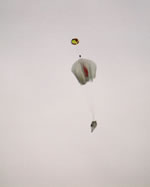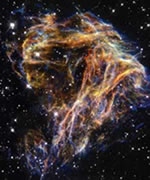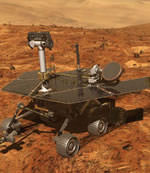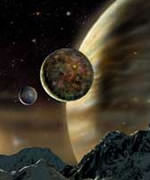NASA has released photographs that show how the space shuttle Atlantis suffered damage from hot gases back in May 2000 when it returned through the atmosphere on a mission. The damage wasn’t permanent and repaired in time for its next mission four months later. NASA blamed the damage on improper installation of a seal between protective panels on the shuttle’s left wing. Atlantis is expected to be the first shuttle to return to space when NASA begins launches again in early 2004.
X-Prize Entrant Completes Drop Test

Image credit: Armadillo Aerospace
Texas-based Armadillo Aerospace successfully performed a helicopter drop test on a component of their spacecraft on Sunday. Armadillo is just one of the teams competing for the X-Prize, which will pay $10 million to the first private space ship capable of lifting three people to an altitude of 100km. The company is led by John Carmack, who’s better known as the founder of id software – creators of the popular video games Doom and Quake.
We finished up all of the prep work for the vehicle on Tuesday. We welded in strapping points to hold 600 pounds of ?passenger? sandbags in the cabin area, and we mounted five 45 pound Olympic barbell plates on a peg at the end to simulate the weight of the final engines, plumbing, and backup recovery system that will be on the full size vehicle. We mounted four 2? throat engine shells as placeholders. Total weight is just under 2400 pounds. We use a combination of multiple chain hoists, a palette jack, and a forklift to move the full vehicle around and get it up on the trailer, but we did wind up breaking one of the castor wheels that we had mounted on our tank cradle. If we wind up having to use the 1600 gallon propellant tank (the current one is 850 gallons), we aren?t going to be able to stand the vehicle up under the main girder inside our shop, which will be inconvenient.
On Saturday, we headed out to our test site for the drop test. There were quite a few stares on the road in transit? We had a few spatters of rain, and the wind occasionally gusted to 12 knots, but we were able to perform the drop in relatively calm 6 knot winds.
Anna rented a big RV for the day, which was very worthwhile. It was nice to be able to take a break in an air-conditioned space.
5 State Helicopters arrived with a big Sikorsky for the lifting. It was very convenient that they were based close by, and didn?t have a problem with our unusual application (although they did have us contact the local mayor and sheriff for explicit permission). We were very impressed with the precision that they were able to do the lifting ? we were afraid that the vehicle might get dragged or bounced on the crush cone, which could buckle it before the test even started, but they were able to perfectly pivot it up on the nose, and gently lift it off the ground. If we had known they were that precise, we probably could have skipped renting the forklift truck for recovery and just had them lower the rocket back onto the trailer after the test.
We made several 18? diameter test parachutes that were weighted to drift at about the same rate that the full size parachute was expected to fall. We did the test drop from 1500? AGL, under the assumption that the big vehicle would fall several hundred feet before the main chute was fully deployed. The landing point for the test parachute was satisfactory, so we planned the full vehicle drop for 2000? AGL. Neil rode in the helicopter to do the parachute releasing, and Anna hung out the side of the helicopter (with a safety strap) to get aerial footage.
We had to abort our first attempt to drop the vehicle, because the line that we ran from the helicopter to the Sea-Catch toggle release above the rocket had wrapped itself around the chain so many times that Neil couldn?t pull it hard enough to trigger the release. This was fixed by tying loose loops of plastic every few feet along the chain, which kept the pull-line in place.
On the second try, the release worked perfectly. You can clearly see the naturally unstable aerodynamics of the vehicle, as it starts to tip over almost immediately after release. We all held our breath as it started to fall, but the drogue immediately inflated and started pulling the main canopy out. It was nine seconds from release to full canopy inflation. The opening shock was negligible, barely hitting 2G?s. For high altitude flights, we are aiming for a 200 mph terminal velocity under the stabilizer drogue at the time of main canopy deployment, so opening shock will be much greater then.
The wake of the main canopy is so great that the deployment drogue just rests on the canopy during descent, without any inflation at all. The real deployment system will have a much longer line on the drogue (because it is used for vehicle stabilization before deploying the main), which will probably cause it to trail behind the main chute, still inflated.
The drift was going about where we expected, but we were a little concerned when we saw that the vehicle was oscillating +/- 13 degrees under the canopy, which is a pretty big swing at that length. The actual landing point was unfortunately just behind some low foliage, so we didn?t get a perfect shot of it, but we did see it hit at enough of an angle that it rolled almost back upright as it landed.
We ran over to collapse the chute and examine the state of the vehicle. The crush cone had buckled right at the mounting point from the angled impact, but the vehicle looked basically sound. None of the sandbags in the cabin had broken open. Two of the engine support studs were bent from when it tipped back up.
We had the helicopter pick it back up and drop it off by the trailer, which was a lot more convenient than driving the lift truck over to the vehicle.
When we got it back to the shop, we pulled some things apart to take a closer look. The bent mounting studs unscrewed right out of their mounts, so replacing those is trivial. We are considering adding some more bracing below the engine plates, which would probably keep them from bending at all. When we got the crush cone off, we did find that the cabin had been bent right at the end of the cone, and the buckle in the crush cone had pushed in far enough to crease the honeycomb bulkhead.
We are probably going to continue using this cabin for the first couple flights of the big vehicle, but start on a second-generation cabin structure that will incorporate some improvements for off-angle landings, as well as several other lessons we have learned in working with the current cabin. Because we bonded a mounting flange to the tank, we should be able to simply swap the cabin when we want to.
The accelerometer data showed 10G acceleration peaks during the landing and bounce, which is over twice what we saw with the straight down drop tests that collapsed perfectly. This is still acceptable, although bouncing up and back down in the cabin would have been a pretty harsh ride. Making some changes to the vehicle structure will improve the behavior of the crush cone and over tipping effects, and we are going to see if Strong Enterprises can do anything with the canopy design to reduce the oscillations during descent.
Overall, the operation was a good success, and demonstrates that recovering the complete vehicle after flight should work fine.
Original Source: Armadillo Aerospace News Release
Test Blasts a Hole in Shuttle Wing
Columbia accident investigators fired a chunk of foam at a sample wing of the space shuttle on Monday, and managed to knock out a 40 centimetre hole. The investigators believe this is the “smoking gun” that proves how events led to the destruction of the space shuttle in February. The impact was so strong that it damaged some of the sensors designed to measure the damage. The board has already made preliminary recommendations about how NASA can improve its policies to reduce risks to the shuttle in the future, but their full report is due later this month.
Opportunity Blasts Off for Mars
NASA’s second Mars Exploration Rover, Opportunity, successfully lifted off from Florida early Tuesday morning after several delays. The launch was halted only seven seconds away from liftoff during the first window because of a problem with a valve on the rocket, but during the second window at 0318 GMT (11:18 pm EDT Monday) the Delta II successfully blasted off. Opportunity will reach Mars on January 25.
Next Space Tourist Selected
US-based Space Adventures has selected the next tourist who will fly into space on board a Russian Soyuz rocket to visit the International Space Station. Space Adventures won’t reveal the identity of the tourist right now, but he or she is expected to blast off some time in 2004 or 2005. The tourist will next be required to sign a contract with the Russian space agency and pay the $20 million fee. If successful, he or she will become the third space tourist after Dennis Tito and Mark Shuttleworth.
Sheets of Debris from a Supernova Explosion

Image credit: Hubble
The most recent image taken by the Hubble Space Telescope shows the delicate looking remnants from a supernova explosion in our nearest galaxy. The remnant, called LMC N 49, is located in the Large Magellanic Cloud, and the supernova would have been visible several thousand years ago. At the core of the object is a rapidly-spinning neutron star which has a magnetic field a quadrillion times stronger than the Earth’s field; objects like this are called magnetars.
Resembling the puffs of smoke and sparks from a summer fireworks display in this image from NASA’s Hubble Space Telescope, these delicate filaments are actually sheets of debris from a stellar explosion in a neighboring galaxy. Hubble’s target was a supernova remnant within the Large Magellanic Cloud (LMC), a nearby, small companion galaxy to the Milky Way visible from the southern hemisphere.
Denoted N 49, or DEM L 190, this remnant is from a massive star that died in a supernova blast whose light would have reached Earth thousands of years ago. This filamentary material will eventually be recycled into building new generations of stars in the LMC. Our own Sun and planets are constructed from similar debris of supernovae that exploded in the Milky Way billions of years ago.
This seemingly gentle structure also harbors a very powerful spinning neutron star that may be the central remnant from the initial blast. It is quite common for the core of an exploded supernova star to become a spinning neutron star (also called a pulsar – because of the regular pulses of energy from the rotational spin) after the immediate shedding of the star’s outer layers. In the case of N 49, not only is the neutron star spinning at a rate of once every 8 seconds, it also has a super-strong magnetic field a thousand trillion times stronger than Earth’s magnetic field. This places this star into the exclusive class of objects called “magnetars.”
On March 5, 1979, this neutron star displayed a historic gamma-ray burst episode that was detected by numerous Earth-orbiting satellites. Gamma rays have a million or more times the energy of visible light photons. The Earth’s atmosphere protects us by blocking gamma rays that originate from outer space. The neutron star in N 49 has had several subsequent gamma-ray emissions, and is now recognized as a “soft gamma-ray repeater.” These objects are a peculiar class of stars producing gamma rays that are less energetic than those emitted by most gamma-ray bursters.
The neutron star in N 49 is also emitting X-rays, whose energies are slightly less than that of soft gamma rays. High-resolution X-ray satellites have resolved a point source near the center of N 49, the likely X-ray counterpart of the soft gamma-ray repeater. Diffuse filaments and knots throughout the supernova remnant are also visible in X-ray. The filamentary features visible in the optical image represent the blast wave sweeping through the ambient interstellar medium and nearby dense molecular clouds.
Today, N 49 is the target of investigations led by Hubble astronomers You-Hua Chu from the University of Illinois at Urbana-Champaign and Rosa Williams from the University of Massachusetts. Members of this science team are interested in understanding whether small cloudlets in the interstellar medium of the LMC may have a marked effect on the physical structure and evolution of this supernova remnant.
The Hubble Heritage image of N 49 is a color representation of data taken in July 2000, with Hubble’s Wide Field Planetary Camera 2. Color filters were used to sample light emitted by sulfur ([S II]), oxygen ([O III]), and hydrogen (H-alpha). The color image has been superimposed on a black-and-white image of stars in the same field also taken with Hubble.
Original Source: Hubble News Release
Another Delay for Opportunity

Image credit: NASA
NASA has pushed back the launch of its second Mars Exploration rover, “Opportunity”, again; this time because of a battery failure on the Boeing Delta II booster. The launch has now been set for Tuesday, July 8 at 0235 GMT (10:35 pm EDT Monday). Even this launch date is at risk, though, as there’s a 30% chance of weather problems. It looks like the previous problem with the booster’s cork insulation has been resolved; although, engineers will be performing further tests to ensure that everything’s fine. The spacecraft must launch before July 15 in order to reach Mars.
The launch of the MER-B Mars Exploration Rover ?Opportunity? aboard a Boeing Delta II rocket has been postponed an additional 24 hours. The delay is due to the failure of a battery cell associated with a component of the launch vehicle?s flight termination system. The battery must be removed and replaced.
Launch is now targeted for no earlier than Monday, July 7. The two launch times available are 10:35:23 and 11:18:15 p.m. EDT. The forecast calls for a 30% chance of not meeting the launch weather criteria on Monday evening.
At Pad 17-B, a tanking test of the Delta rocket was conducted this morning. The first stage was loaded with cryogenic liquid oxygen to evaluate the bonding of the lower band of cork thermal insulation. This afternoon, NASA and Boeing managers met to discuss the outcome of the tanking test and other associated testing and engineering evaluations that have been conducted over the last several days.
After the tanking, inspections revealed some selective debonding of the cork from the surface of the vehicle within a limited area. These locations are being repaired using a different adhesive with a stronger bonding characteristic as demonstrated by tests conducted at KSC late this week. This work was completed tonight and the problem has been resolved to the satisfaction of engineers.
Original Source: NASA News Release
Mobile Edition of Universe Today
I’ve had a few requests for this, so I’m taking a stab at creating a mobile version of Universe Today. I always like to start this kind of thing small and build from there, so I’ve created a special page with a slimmed-down version of the homepage, with the first 5 stories.
But I need your help. If you have a mobile device, like a Blackberry, Palm Pilot, web-enabled phone, etc, can you do me a favour and take a look at the page? Here’s a link to it. This page will stay up to date with the home page. My page should look good, but the external links to other sites won’t fit so well.
My next question is to figure out a way to send this out to people, so I’m looking for some volunteers with various portable devices to let me experiment with various ways of delivering this to you. I was thinking of just adding another newsletter in a wireless format. Obviously this’ll be totally free as well.
If you want to take part, just drop me an email and I’ll coordinate with you.
Thanks!
Fraser Cain
Publisher
Universe Today
Japanese Space Shuttle Prototype Crashes
The prototype for a Japanese-built space shuttle crashed on landing Tuesday, breaking its left wing and nose cone. The 4-metre unmanned prototype was lifted by balloon in Sweden to an altitude of 21 kilometres and then plunged back to Earth, reaching 80% the speed of sound. Unfortunately, two of its three parachutes failed to open and it had a hard landing. Controllers got the aerodynamic data they needed, but the prototype is likely too damaged to be used again for future tests.
Similar Solar System Discovered

Image credit: PPARC
A team of international astronomers have discovered a planet which is remarkably similar to Jupiter. This new planet circles a star called HD70642 (in the constellation of Puppis) 90 light-years from Earth. It’s twice the mass of Jupiter and its orbit is nearly circular around HD70642 at a distance similar to Jupiter’s from our own Sun. Furthermore, there don’t seem to be any larger planets closer to the star. This planetary discovery is the most similar to our own solar system found so far.
Astronomers looking for planetary systems that resemble our own solar system have found the most similar formation so far. British astronomers, working with Australian and American colleagues, have discovered a planet like Jupiter in orbit round a nearby star that is very like our own Sun. Among the hundred found so far, this system is the one most similar to our Solar System. The planet’s orbit is like that of Jupiter in our own Solar System, especially as it is nearly circular and there are no bigger planets closer in to its star.
“This planet is going round in a nearly circular orbit three-fifths the size of our own Jupiter. This is the closest we have yet got to a real Solar System-like planet, and advances our search for systems that are even more like our own,” said UK team leader Hugh Jones of Liverpool John Moores University.
The planet was discovered using the 3.9-metre Anglo-Australian Telescope [AAT] in New South Wales, Australia. The discovery, which is part of a large search for solar systems that resemble our own, will be announced today (Thursday, July 3rd 2003) by Hugh Jones (Liverpool John Moores University) at a conference on “Extrasolar Planets: Today and Tomorrow” in Paris, France.
“It is the exquisite precision of our measurements that lets us search for these Jupiters – they are harder to find than the more exotic planets found so far. Perhaps most stars will be shown to have planets like our own Solar System”, said Dr Alan Penny, from the Rutherford Appleton Laboratory.
The new planet, which has a mass about twice that of Jupiter, circles its star (HD70642) about every six years. HD70642 can be found in the constellation Puppis and is about 90 light years away from Earth. The planet is 3.3 times further from its star as the Earth is from the Sun (about halfway between Mars and Jupiter if it were in our own system).
The long-term goal of this programme is the detection of true analogues to the Solar System: planetary systems with giant planets in long circular orbits and small rocky planets on shorter circular orbits. This discovery of a -Jupiter- like gas giant planet around a nearby star is a step toward this goal. The discovery of other such planets and planetary satellites within the next decade will help astronomers assess the Solar System’s place in the galaxy and whether planetary systems like our own are common or rare.
Prior to the discovery of extrasolar planets, planetary systems were generally predicted to be similar to the Solar System – giant planets orbiting beyond 4 Earth-Sun distances in circular orbits, and terrestrial mass planets in inner orbits. The danger of using theoretical ideas to extrapolate from just one example – our own Solar System – has been shown by the extrasolar planetary systems now known to exist which have very different properties. Planetary systems are much more diverse than ever imagined.
However these new planets have only been found around one-tenth of stars where they were looked for. It is possible that the harder-to-find very Solar System-like planets do exist around most stars.
The vast majority of the presently known extrasolar planets lie in elliptical orbits, which would preclude the existence of habitable terrestrial planets. Previously, the only gas giant found to orbit beyond 3 Earth-Sun distances in a near circular orbit was the outer planet of the 47 Ursa Majoris system – a system which also includes an inner gas giant at 2 Earth-Sun distances (unlike the Solar System). This discovery of a 3.3 Earth-Sun distance planet in a near circular orbit around a Sun-like star bears the closest likeness to our Solar System found to date and demonstrates our searches are precise enough to find Jupiter- like planets in Jupiter-like orbit.
To find evidence of planets, the astronomers use a high- precision technique developed by Paul Butler of the Carnegie Institute of Washington and Geoff Marcy of the University of California at Berkeley to measure how much a star “wobbles” in space as it is affected by a planet’s gravity. As an unseen planet orbits a distant star, the gravitational pull causes the star to move back and forth in space. That wobble can be detected by the ‘Doppler shifting’ it causes in the star’s light. This discovery demonstrates that the long term precision of the team’s technique is 3 metres per second (7mph) making the Anglo-Australian Planet Search at least as precise as any of the many planet search projects underway.
Original Source: PPARC News Release
